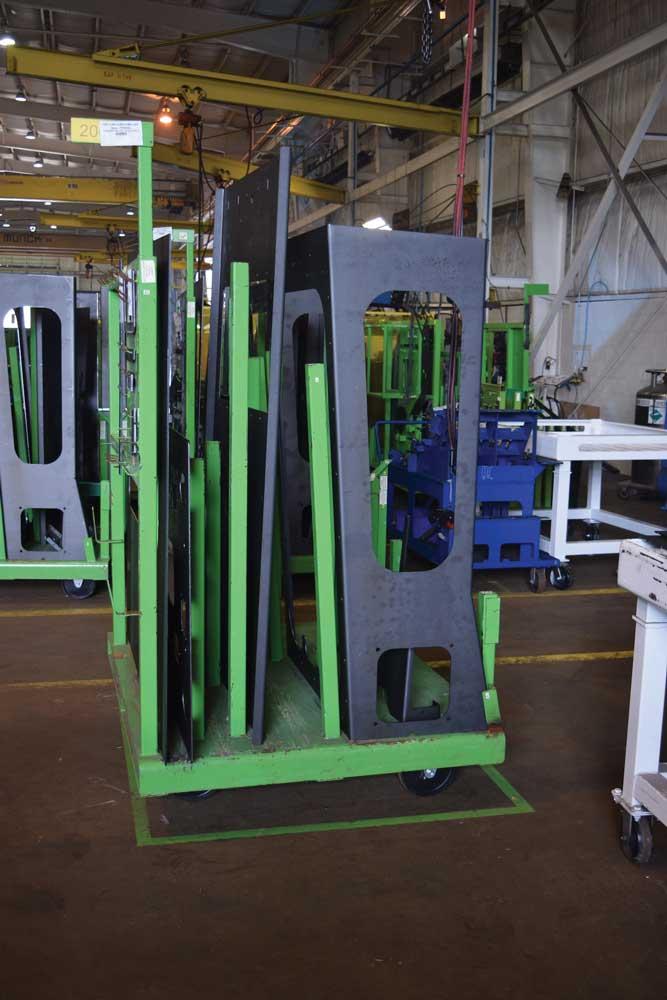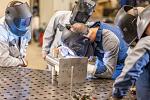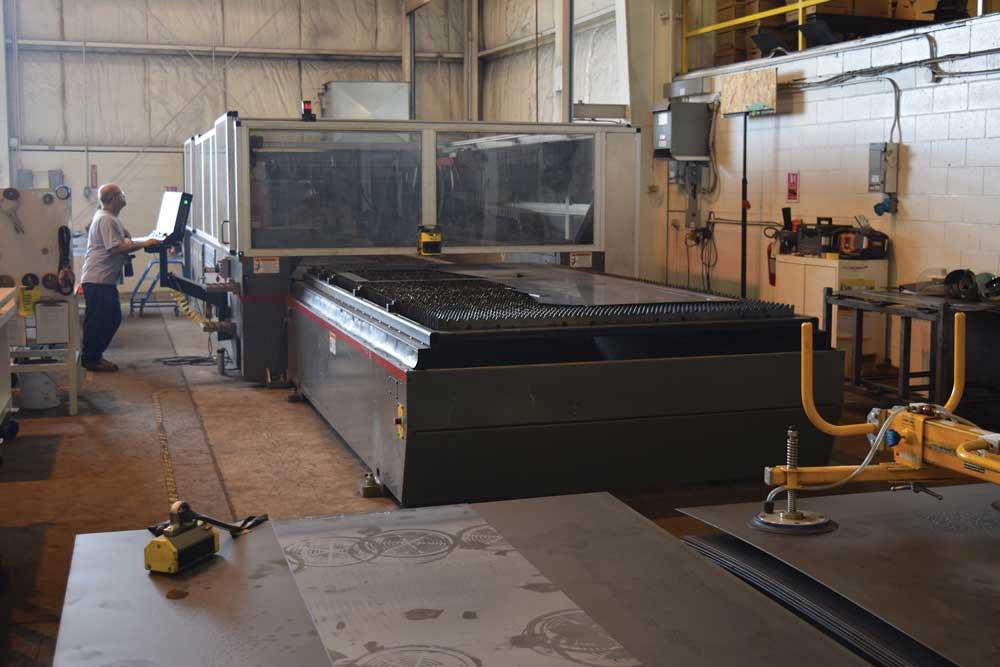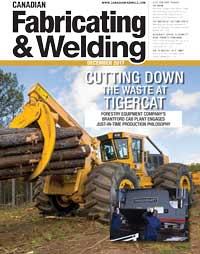Editor
- FMA
- The Fabricator
- FABTECH
- Canadian Metalworking
Cutting down the waste at Tigercat
Forestry equipment company’s Brantford cab plant engages just-in-time production philosophy
- By Rob Colman
- December 14, 2017
- Article
- Fabricating
Tigercat Industries Inc. is a forestry and off-road industrial equipment manufacturer with nine different facilities in southwestern Ontario. The company was started in 1992 as an offshoot of MacDonald Steel. Owner Ken MacDonald decided the company needed to develop an end product of its own to keep its steel fabrication business operating to capacity. That first product was a drive-to-tree feller buncher designed specifically for the southeast U.S. The small Tigercat team had uncovered significant deficiencies in the machines that were available to the market at the time and tasked itself to build a better alternative.
Since then the company has branched out into skidders, loaders, and peripheral equipment that can serve both the forestry industry and other off-road industrial needs.
“One of the greatest benefits Tigercat supplies to its customers is its engineering expertise,” said Paul Iarocci, communications manager for Tigercat. “There is a lot of dialogue between the people that are designing the machines and the end users, and our customers tell us how important that is. They can actually see their suggestions and wants and needs designed into our products. And often we can react quickly to customer requests for improvements or new machines. Most of our competitors can’t do that as easily.”
The company’s growth has created opportunities for it to rethink its production processes. Most recently it was decided that most cab production would be consolidated in one facility on Morton Avenue East in Brantford, Ont.
Tigercat has owned the building the cabs are being built in now since 1998. It most recently served as a parts facility and has been the company’s head office for about a decade. With the purchase of a new building across the street, the company has moved the parts department, and this newly focused cab production plant opened just last year.
Simplified Bending
Cabs for industrial equipment are complex. The shape demands a number of weldments in awkward positions, and the variety of metal components included require cutting, forming, and bending of many parts that range widely in size. Beyond the metal, there’s paint, insulation, and electronics to consider for the assembly.
Tigercat is dedicated to having this facility follow the lean manufacturing model commonly known as the Toyota Production System.
“We don’t have room for warehouses of inventory here, so our main objective is to use one-piece flow whenever possible throughout the facility,” said Jason Iles, plant manager for the cab production facility.
“We purchased a Cincinnati 4-kW CO2 laser cutting table and two Cincinnati press brakes (one 350 tons and one 230 tons) to process our raw materials at the front of our production line,” Iles continued. “Before the equipment even arrived, we focused on how to process one cab at a time and not batch-produce parts.”

By adopting a newer style of tooling on this Cincinnati press brake, operators have been able reduce tooling changeovers substantially.
Even for laser cutting, Iles’ first priority isn’t nesting as many parts as possible on one sheet, it’s making sure that the press brake is fed with one cab’s worth of material when it is required.
“We standardized material thicknesses to reduce the number of changeovers, which will simplify ordering and allow us to add new efficiencies to our nesting,” said Iles. “We are working with engineering all the time to increase efficiencies through manufacturing process improvements.”
Standardization is important for Tigercat as a company. It uses Cincinnati presses and lasers throughout its facilities.
“I’m happy with their accuracy,” said Iles. “Longevity-wise, they are a good product. The software that is available now allows us to put all of the information to build each individual cab on the machines. This allows operators to see what part they should be working on and how it needs to be processed.”
Tooling is one place where Iles’ team has found some efficiencies.
“Through continuous improvement, our Brake Out team switched to dies that reduced changeovers and improved the quality of formed profiles. The tooling uses inserts that wrap material around the punch, rather than being pushed into traditional V-style tooling,” said Iles. “The quality of the finished product is much better, with virtually no die marks on the steel. Any holes or cutouts close to bend lines don’t experience any flaring. You can also form much smaller flanges to material.”
Getting Employees Engaged
“Through our structured approach to continuous improvement, our team members take steps daily to solve problems. We set targets and collect data on our current condition, then look at the obstacles that are preventing us from reaching our target,” said Iles. “Using this approach, we have the team members identifying problems in their process and empower them to implement changes towards reaching team targets. These steps are small increments of change that are measured to see if they work. Failure is not frowned upon as long as we learn and adjust from their next steps. We want our team members to work outside their comfort zone and into an innovative zone. Be creative. We believe employee engagement is key to our success.”
To make improvement efforts easier, Iles and his team focus on standardizing processes. “If everyone does their process the same way, our safety, quality and productivity repeat,” said Iles. “Our problems also repeat, and the process dictates what improvements need to be made.”
Following a Leader

All items for one cab are kitted out on a custom-designed carrier to move them from bending to welding.
Iles is by no means blazing a new trail at Tigercat with the work he is doing at the Morton Avenue East plant. Rather, he’s following the lead of what might be considered the jewel in the crown of Tigercat’s just-in-time commitment – the company’s Savage Drive plant in Cambridge, Ont. This facility manufactures the company’s 600-series skidders.
“Because we’ve leaned out our production, we’ve reduced our cycle times drastically,” said Joe Barroso, vice president at Tigercat and the driving force at the Savage Drive plant. “It used to take 300 hours to build one of these machines, and we’re nowhere near that anymore.”
Barroso noted that fittings and hardware now come into his facility kitted out for one machine at a time.
“We are trying to do this with every single component so that there’s no stock except what is on the assembly line,” he said.
Visually it is also easy to monitor production on the factory floor. The Savage Drive facility does not use an MRP system, but Barroso explained that, with the use of a board that his team designed and by taking a quick walk around the floor, anyone who works in the facility could tell a visitor where they are in production and whether they are running behind anywhere.
“Ten years ago it would have been possible to walk out on the floor and ask someone if we were on schedule and they wouldn’t have had a clue,” said Barroso. “Now they can tell you within a 60-minute window where we are. As things move on our manual board, it triggers everyone in the factory to do something – to buy things, or to make things. It’s simple and more efficient than doing it on a computer.”
As for finding more efficiencies, Barroso said that it’s an endless process, requiring constant dialogue with purchasing and design to push efficiencies through the process. But there’s no denying that, in more than 10 years of keeping his team’s eyes on the seven wastes and the flow of product, Barroso has managed to make the Savage Drive plant a model of what Iles and his team are striving for.
“When I came to this facility 13 years ago, it was producing 200 machines a year and there was no room to move,” said Barroso. “Now we are making 500 to 600 machines in the same building, and there’s room to grow.”
In the course of its first 25 years, Tigercat has become a leader in its field and continues to expand.
Editor Robert Colman can be reached at rcolman@canadianfabweld.com.
Tigercat Industries Inc., 519-753-2000, www.tigercat.com
About the Author

Rob Colman
1154 Warden Avenue
Toronto, M1R 0A1 Canada
905-235-0471
Robert Colman has worked as a writer and editor for more than 25 years, covering the needs of a variety of trades. He has been dedicated to the metalworking industry for the past 13 years, serving as editor for Metalworking Production & Purchasing (MP&P) and, since January 2016, the editor of Canadian Fabricating & Welding. He graduated with a B.A. degree from McGill University and a Master’s degree from UBC.
subscribe now


Keep up to date with the latest news, events, and technology for all things metal from our pair of monthly magazines written specifically for Canadian manufacturers!
Start Your Free Subscription- Trending Articles
Class is in session for college connections

BlueForge Alliance partners with Nuts, Bolts & Thingamajigs to develop Submarine Manufacturing Camps

Engine-driven welding machines include integrated air compressors

Orbital tube welding webinar to be held April 23

Portable system becomes hot tech in heat treatment

- Industry Events
ZEISS Quality Innovation Days 2024
- April 15 - 19, 2024
Tube 2024
- April 15 - 19, 2024
- Düsseldorf, Germany
CTMA Economic Uncertainty: Helping You Navigate Windsor Seminar
- April 30, 2024
- Windsor, ON Canada
MME Winnipeg
- April 30, 2024
- Winnipeg, ON Canada
CTMA Economic Uncertainty: Helping You Navigate Kitchener Seminar
- May 2, 2024
- Kitchener, ON Canada

















